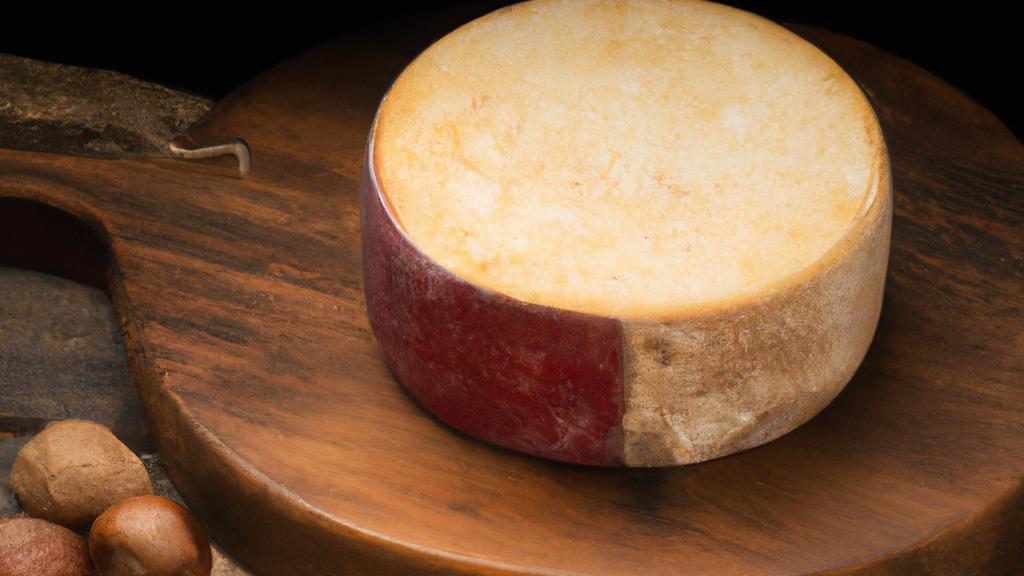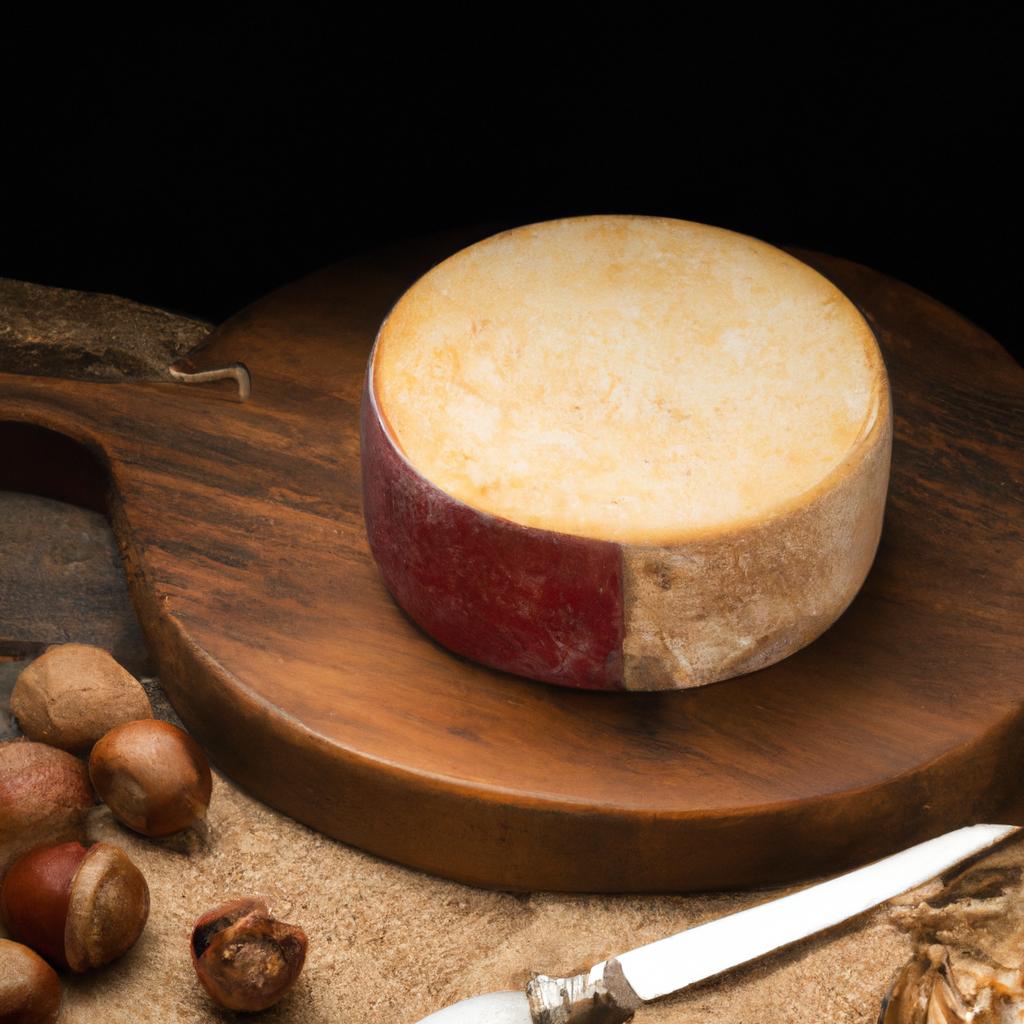
The rich and flavorful Kashkaval cheese, a culinary staple in the Balkan countries, holds pride of place in many regional delicacies. Its unique taste and superior quality make it a celebrated cheese in Bulgaria, Romania, North Macedonia, and other Southeast European countries, as well as in the Middle East, where it is known as Kaşkaval. Cheese aficionados across the globe cherish Kashkaval for its smooth, slightly salty flavor profile and compact, semi-hard texture, often comparing it to the esteemed Italian Pecorino or Provolone cheeses.
There are two primary types of Kashkaval cheese, each bringing forth a distinctive character of this dairy delight: Kashkaval Vitosha, a top-quality sheep’s milk variant, and Kashkaval Balkan, typically crafted from cow’s milk. Sheep milk lends Kashkaval Vitosha a delicate nutty essence, and a firmer, denser texture, while the Balkan version, made from cow’s milk, provides a milder flavor profile with a softer, more elastic texture. Both variants offer a prominent organoleptic profile with a pronounced tangy note, a characteristic that sets Kashkaval apart from many other cheeses.
- Kashkaval Vitosha: Recognised by its iconic yellow tint and piquant aftertaste, Kashkaval Vitosha is traditionally made using raw or pasteurized sheep’s milk. The manufacturing method involves the milk being heated to a considerable temperature, after which cultured rennet is mixed in to create curds; a step vital for instigating lactic fermentation. The resultant curds are then selectively cut, drained and pressed into specific moulds, attributing the cheese its signature cylindrical shape.
- Kashkaval Balkan: Produced predominantly from cow’s milk, Kashmir Balkan is characterized by a gentle buttery flavor and smooth texture. The production process is almost identical to that of its sheep’s milk counterpart, with slight differences in the maturation period and the final texture of the cheese, which is softer and more elastic in this version. The cow’s milk adds an attractive creaminess, making this variant a popular choice for culinary uses, such as grilling or topping on bread.
Both variants of Kashkaval cheese are meticulously aged for at least two months to enhance depth and complexity in their flavor notes and ensure its characteristic firm, yet not hard texture. They provide exciting gastronomic possibilities, making them an essential addition to an array of indulgent, flavoursome dishes such as cheese-based sauces, soups, pizzas, and stuffed pastries. For a delightful gustatory expedition, Kashkaval cheese can be paired with a robust red wine such as Cabernet Franc or a crisp white such as Viognier.
Welcome to our short quiz about the renowned Kashkaval Cheese of Bulgaria! Do you think you’re knowledgeable about this iconic Bulgarian product? Start the quiz now and find out!
Unraveling the Intricacies of Kashkaval: Ingredients, Properties, and Varieties
The cheese gastronomy world would be bereft without Kashkaval, a delectable cheese hailing from the Balkans that has won over the hearts of gourmands worldwide. Known for its unique semi-hard texture, variant flavors ranging from mild to tangy, and brilliant versatility in culinary use, Kashkaval is a culinary wonder, bundled up in a rounded form often resembling a cheese wheel. The high-quality milk, superior fermentation process, and careful maturation protocol underline the unassailable standards that go into manufacturing this globally coveted cheese.
Kashkaval consists of innocuous and nutrient-rich ingredients that contribute to its distinctive properties. These include:
- Milk – primarily sheep’s milk, but cow’s, goat’s, or buffalo’s milk can also be used. These variants often influence the cheese’s subtle flavor differences.
- Rennet – a complex set of enzymes from animal stomachs, mainly used to coagulate the milk protein and catalyze the cheese-making process.
- Salt – apart from seasoning, sodium chloride plays a crucial role in maintaining Kashkaval’s texture and longevity by warding off detrimental bacteria.
- Culture – the starter culture, consisting of lactic acid bacteria, initiates and expedites the fermentation process.
The properties of Kashkaval largely depend on the milk used in its production and the aging period, both integral to the cheese’s final flavor, aroma, and texture profile. When freshly made, Kashkaval swims in subtleness, barely trickling the taste buds with its soft creamy tantalization. With age, this unassuming cheese takes on a sharper, piquant flavor, acquiring a harder consistency in the process. The resultant semi-hard texture is the reason behind Kashkaval being the cheese of choice in several dishes, enduring well in both baking and frying.
The varieties of Kashkaval are numerous, each beaming with distinct qualities spanning across countries and traditions. Prominent examples include Kashkaval Vitosha from Bulgaria, known for its striking, mildly tangy flavor, and Kashkaval Balkan, a variant lauded for its firm texture and hearty, full-bodied taste. The distinctive Kashkaval Preslav is celebrated for its consummate balance of creaminess and tanginess, while Kashkaval Cherni Vit stands apart with its unique green color due to the particular Penicillium mold used during the production, contributing an unparalleled visual and gustatory experience.
Kashkaval is a popular cheese that originates from the Balkan region, primarily found in Bulgaria, Romania, and the Republic of Macedonia. This semi-hard cheese is made from cow’s milk, sheep’s milk, or a combination of the two.
Bulgaria, one of the main producers of Kashkaval, is renowned for its rich dairy industry. The country boasts picturesque landscapes with vast green pastures where cows and sheep graze freely, resulting in high-quality milk. The combination of favorable climate, fertile soil, and traditional cheese-making techniques contribute to the exceptional flavors and textures of Bulgarian Kashkaval.
Romania, another significant producer of Kashkaval, possesses a diverse range of terrains, including picturesque mountains and fertile plains. This geological variation provides ample grazing opportunities for livestock, resulting in a diverse array of ingredients used to make Kashkaval. Romanian Kashkaval is known for its unique taste profile, combining creamy, savory, and slightly nutty flavors.
The Republic of Macedonia, also known as North Macedonia, is renowned for its thriving dairy industry. Located in the heart of the Balkans, this region benefits from a Mediterranean climate, making it an ideal environment for dairy farming. Macedonian Kashkaval is characterized by its creamy texture and slightly tangy taste.
In each of these countries, Kashkaval is produced using traditional cheese-making methods handed down through generations. The cheese is typically aged for several months, allowing its flavors to develop and intensify. Kashkaval is a versatile cheese that can be enjoyed on its own, grated over dishes, or melted into a delicious fondue.
Key Points: – Kashkaval is a semi-hard cheese made from a combination of cow’s milk and sheep’s milk. – Bulgaria, Romania, and the Republic of Macedonia are the main producers of Kashkaval. – These countries offer favorable conditions for dairy farming, including ample grazing opportunities and traditional cheese-making techniques. – Kashkaval is aged for several months to develop its flavors. – The cheese is known for its creamy texture, savory taste, and slight nuttiness.
– Kashkaval is a versatile cheese that can be enjoyed in various culinary preparations.
Exploring the Versatility of Kashkaval Cheese in Daily Cuisine
In the realm of cheeses, the Bulgarian Kashkaval cheese, with its round and rich tang, is an utter delight. A semi-hard, yellow variety, the cheese’s distinctive flavors interweave the earthy punch of sheep’s milk with the lighter creaminess of cow’s milk. This specificity makes it a striking addition for an array of recipes.
The Kashkaval is effortlessly adaptable, weaving its way into breakfast dishes, appetizers, gourmet entrees, or even a simple yet satisfying late-night snack. What’s more, its unique, pleasant aroma, slightly salty taste, and perfect fusion of creaminess and firmness make it an absolute head-turner in any dish. Let’s explore two gourmet dishes leveraging the depth and richness of this unique cheese.
Gourmet Kashkaval Cheese-stuffed Bread Recipe
Cheese-stuffed Kashkaval Bread
- 1 round loaf of rustic bread
- 300g of Kashkaval cheese, sliced
- 3 tbsp of olive oil
- 2 cloves of garlic, minced
- 1 bunch of chopped fresh parsley
- Slice the top of the bread and hollow out enough room for the cheese. Brush inside with olive oil and sprinkle half of the garlic.
- Insert Kashkaval cheese, sprinkle remaining garlic, drizzle with more olive oil, and replace the top of the bread.
- Wrap the entire loaf with aluminum foil and bake for 20 minutes at 180°C. Remove the foil and brown the top for a final 5 minutes. Sprinkle with fresh parsley before serving.
-
Traditional Bulgarian Fried Kashkaval Recipe
Fried Kashkaval
- 300g of Kashkaval cheese
- 2 eggs
- 1 cup of flour
- 1 cup of breadcrumbs
- Oil for frying
- Cut the cheese into strips. Dip each strip into flour, then whisked eggs, and finally breadcrumbs.
- Heat the oil in a frying pan and add cheese strips. Cook until golden brown on each side. Drain on kitchen paper before serving.
- These recipes not only underscore the versatility of the Kashkaval cheese, but also bring to light a culinary journey intersecting the lines of tradition and innovation simultaneously.
- Kashkaval cheese is considered a staple in Bulgarian cuisine.
- Apart from Bulgaria, Kashkaval is also popular in other countries like Romania, Greece, North Macedonia, and Serbia.
- It has a tangy and slightly salty flavor that makes it versatile for various dishes.
- In 2019, Bulgaria produced nearly 5,000 tons of Kashkaval cheese.
- Kashkaval cheese, when properly wrapped, can be stored up to several months.
- The cheese is commonly used in pastries, sandwiches, salads, and other Bulgarian dishes.
- There are also sheep’s milk and buffalo’s milk variants of Kashkaval cheese.
Deciphering the Delicate Balance: Pairing Kashkaval Cheese with Wines and Dishes
Featuring an aromatic richness and a semi-hard texture, Kashkaval cheese is a prevalent ingredient esteemed in the Balkan and Middle Eastern cuisine. Graced with a slightly piquant flavor, this cheese has earned recognition for its excellent melting properties, making it a beloved topping for a variety of dishes. It is equally remarkable when served alone or paired with wines, as its full-bodied flavor profile can stand up to robust red wines while also harmonizing with light-bodied white wines.
When selecting wines for Kashkaval cheese, seek reds such as Rioja, Merlot or Syrah for their fruit-forward notes and robust character that beautifully counterbalance the cheese’s sharpness. These wines add a layer of complexity to the cheese, revealing hidden nuances in its taste. With white wines, opt for a Chenin Blanc or a Fumé Blanc whose high acidity and citrus elements provide a crisp contrast to the earthy tones of the cheese, thus facilitating a provocative interplay of flavors on the palate.
When it comes to food pairings, Kashkaval cheese exhibits its versatility and adaptability splendidly. Here are some flavorful combinations you might want to explore:
- ‘Pogacha’, a traditional Balkan bread often filled with Kashkaval cheese, allows the slightly salty, tangy cheese to star in a simple yet satisfying dish.
- Vegetables like grilled peppers or eggplants sync exquisitely well with Kashkaval cheese due to their mild, smoky flavor profiles.
- Nuts such as almonds or walnuts either raw or roasted, offer a delightful textural contrast and complementary flavors.
- For a heartier option, incorporate Kashkaval cheese into dishes like ‘Musaka’, a type of baked potato dish, and use its melting propensity to elevate the overall texture and richness.
Whether you wish to savor Kashkaval cheese in its unadulterated form with a suitable wine, or incorporate it into a gourmet dish, the sheer variety and matchless taste profile of this cheese promises an unforgettable gastronomic venture.
Similar Cheeses for Kashkaval
Kashkaval is a popular cheese that originated in the Balkans and is widely consumed in various countries such as Bulgaria, Romania, Turkey, and Greece. It is a semi-hard cheese made from cow’s milk, sheep’s milk, or a combination of the two. Kashkaval is known for its smooth and creamy texture, along with its slightly tangy and nutty flavor.
If you’re a fan of Kashkaval and looking to explore other cheeses with similar characteristics, here are a few options you should consider:
1. Provolone: This Italian cheese is made from cow’s milk and is often aged to develop a firm yet creamy texture. Provolone has a rich and buttery taste with a hint of sweetness. It can be enjoyed both melted and sliced, making it a versatile option for various dishes.
2. Manchego: Hailing from Spain, Manchego is a sheep’s milk cheese with a distinct crumbly texture. It has a slightly salty and nutty flavor profile, which becomes more pronounced as it ages. Manchego is often enjoyed on its own or paired with fruits and nuts for a delightful cheese platter experience.
3. Pecorino Romano: Another popular sheep’s milk cheese from Italy, Pecorino Romano, is well-known for its sharp and salty taste. It has a hard, granular texture that makes it perfect for grating over pasta dishes or salads. Pecorino Romano is a great alternative if you prefer a more intense and robust flavor.
4. Gouda: Originating from the Netherlands, Gouda is a versatile cheese that is available in various age categories. Young Gouda has a softer texture and a mild, creamy flavor, whereas aged Gouda becomes harder and develops a richer, caramel-like taste. It is a crowd-pleasing cheese that can be enjoyed on its own or used in cooking.
These cheeses share some similarities with Kashkaval, either in terms of texture, flavor, or both. However, each cheese also has its own unique characteristics, so it’s worth trying them all to discover your personal favorites. Whether you enjoy them on a cheese board, in sandwiches, or melted over dishes, these cheeses are sure to enhance your culinary experience.
 About the author: Dr. Wolfgang Sender writes on international careers. He is founder of Life-in-Germany.de and Jobs26.com.
About the author: Dr. Wolfgang Sender writes on international careers. He is founder of Life-in-Germany.de and Jobs26.com.



